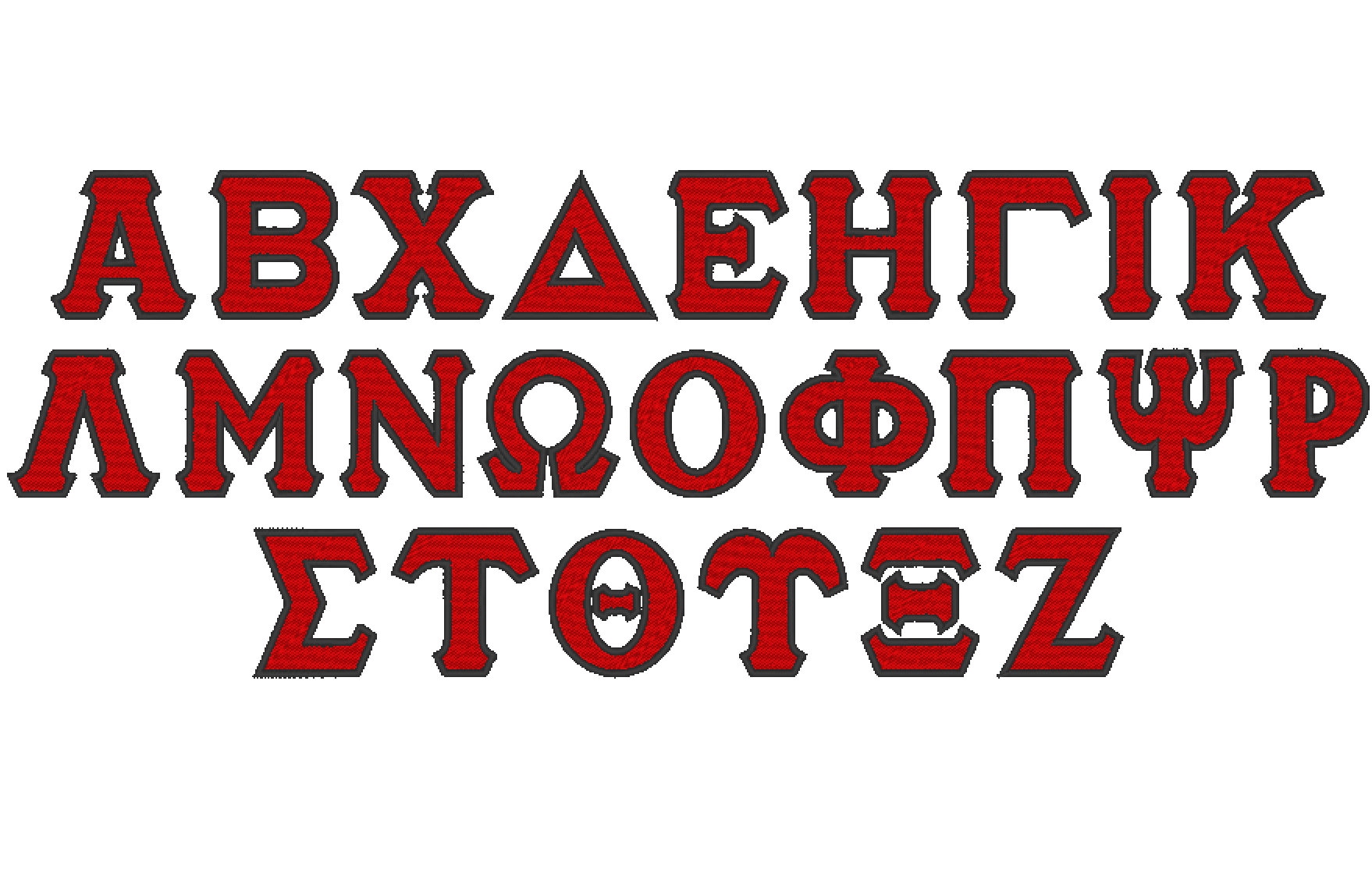Greek font for Mac (mac928.sit.hqx). Download Greek font for Linux How to use the Greek keyboard: Use Ctrl+Shift or Left Alt+Shift to switch between the English and Greek keyboards or any other installed keyboards. Free Greek fonts by Magenta (Canonica is polytonic) Unicode Polytonic Greek for the World Wide Web. The best website for free high-quality Koine Greek fonts, with 14 free Koine Greek fonts for immediate download, and 56 professional Koine Greek fonts for the best price on the Web.
- Microsoft Greek Fonts Download
- Greek Fonts For Mac Free Download Pc
To use Greek and Hebrew in your documents, you can now choose between two different approaches:
- Use special fonts that display English letters as though they were Greek and Hebrew, such as the common fonts produced by BibleWorks: bwgrkl for Greek and bwhebb for Hebrew.
- Use Unicode to actually type Greek/Hebrew text alongside English. Many fonts support the full Unicode character set.
Whenever possible, use Unicode! Here's why:
- Unicode is the international standard for handling characters for all foreign languages, not just Greek and Hebrew.
- Unicode text will print more reliably.
- Unicode is the only way to post Greek/Hebrew to the web (see the examples of 2 Timothy 2:15 below).
- Unicode
- σπούδασον σεαυτὸν δόκιμον παραστῆσαι τῷ θεῷ, ἐργάτην ἀνεπαίσχυντον, ὀρθοτομοῦντα τὸν λόγον τῆς ἀληθείας.
- BibleWorks font
- spou,dason seauto.n do,kimon parasth/sai tw/| qew/|( evrga,thn avnepai,scunton( ovrqotomou/nta to.n lo,gon th/j avlhqei,ajÅ
(This line will not look like Greek unless you have the BW font on your computer.)
Try copying and pasting each of these verses into a plain text editor like Windows Notepad, and you should see the difference between the actual Greek characters used by Unicode and the masked English characters used by the BibleWorks font.
This page aims to help you install, configure, and use the biblical languages using either approach.


Affiliate Network : new service locations
Please click here to see our Affiliate network and various locations in Greece where we can immediately assist you
For cases outside Greece, we service them via our affiliate network of McLarens Global Claim Services.
READING GREEK ON THE WWW
download greek fonts for PC and MAC
Microsoft Greek Fonts Download
Here you can find instructions on installing Greek fonts on your System and setting up your browser in order to read web pages with Greek content.
|
| PLATFORM | DOWNLOADS/INSTRUCTIONS |
| MS WINDOWS | True type fonts (click links below to download) - Arial Greek (arialgreek.zip) (161 kb)
- Hellas Arial (arial.exe) (112 kb)
- Hellas Times New Roman (times.exe) (143 kb)
- Avant Greek (avant.exe) (46 kb)
- Download one (or more) Greek font file from the above list and save it in a temporary folder (eg. C:temp).
- Run the file (double click) to extract the fonts it contains.
- From the Control Panel (START-Settings-Control Panel), double click on fonts icon to launch fonts window. From menu File, choose Install new font...
- Select the downloaded fonts from the folder you've just extracted them and click OK.
For more information about Greek support on Windows platforms, you can visit http://www.hri.org/fonts/
|
MACINTOSH
True type fonts I | True type fonts I : Times new Roman, Arial (click link below to download) - Greek Mac fonts I (2.9 mb)
- Download the file above.
- You have to decompress it. You can use Stuffit Expander to decompress the file. Normally this application must already be installed by your system.
- After decompressing the file run the file created. It will automatically install new fonts to your system (Times_new_Roman, Arial)
- Configure your browser to use one of the new fonts.(See Browser Setup section below)
For information about Greek support on Macintosh platforms, you can visit http://www.hri.org/fonts/mac/
|
MACINTOSH
True type fonts II | True type fonts II : HellasHelvetica, HellasTimes, HellasFun (click link below to download) - Greek Mac fonts II (223 kb)
- Download the file above.
- You have to debin-hex and decode the file (decompress). You can use Stuffit Expander to decompress the file. Normally this application must already be installed by your system.
- After decompressing the file a new folder is created with various fonts (HellasHelvetica, HellasTimes, HellasFun). From the new folder, drag font files into folder 'Fonts' of the 'System' folder.
- Configure your browser to use Hellas Helvetica font.(See Browser Setup section below)
For information about Greek support on Macintosh platforms, you can visit http://www.hri.org/fonts/mac/
|
| UNIX | For more information about Greek support on Unix platforms , you can visit http://www.hri.org/fonts/unix/
|
a. MS WINDOWS BROWSER SETUP
Here you can find instructions about Netscape's Navigator/Communicator and Microsoft's Internet Explorer. If you are using older versions of these browsers we suggest that you upgrade to the last ones (N4.6x and IE5.x respectively).
- Microsoft Internet Explorer Versions 5.x:
- Select the fonts that should be used by the browser for the Greek encoding.
Go to: Tools - Internet Options - Fonts. Select Greek in the 'Language Script' area.
At the Web-page font select a Greek one you have extracted e.g. Arial Greek and at the Fixed-width font select Courier New. - Select the language that should be used by the browser.
Go to: Tools - Internet Options - Languages. Add the greek language at the list and put it at the top. - Select a default encoding.
To do this, you need to select View - Encoding - Greek ISO, or View - Encoding - Greek Windows. Also, if the Autoselect option is checked, uncheck it.
- Microsoft Internet Explorer Versions 4.x:
- Go to: View - Internet Options - Fonts.
There, include Greek in the Character Sets area. Click once on 'Greek', then choose Greek Alphabet (ISO) from the Character Set drop-down menu and then click on the Set as Default button. - You then should change the default fonts for the Proportional font and the Fixed-width font, to e.g. Arial Greek and Courier New respectively.
- Netscape (versions 4.x):
- Select the fonts that should be used by the browser for the Greek encoding.
To do this, you need to select Edit - Preferences - Appearance - Fonts.
Here, you should change 'For the Encoding' to Greek, and enter fonts such as Arial Greek for the Variable Width Font, and Courier New for the Fixed Width Font. For the 'Sometimes a document will provide its own fonts.' option select Use document specified fonts, including Dynamic Fonts. However, if you run across a page that should be in Greek but appears in gibberish, you might want to try changing this option to Use my default fonts, overriding document-specified fonts. - Select the language that should be used by the browser.
To do this, you need to select Edit - Preferences - Navigator - Languages.
Here, you should add the Greek language and put it on top of the list. - Select a default encoding.
To do this, you need to select View - Encoding - Greek ISO-8859-7, or View - Encoding - Greek Windows-1253. Also select View - Encoding - Set Default Encoding.
- Netscape Versions 3.x:
- Select the fonts that should be used by the browser for the Greek encoding.
To do this, you need to select Options - General Preferences - Fonts. For each of the Use the Proportional Font and Use the Fixed Font you should click on the Choose Font button, and select a font. Before clicking the OK button, make sure that the Script: option is set to Greek. - Select a default encoding.
To do this, you need to select Options - Document Encoding - Greek. Also select Options - Document Encoding - Set Default.
- Netscape (versions 4.5 and up):
- Select the fonts that should be used by the browser for the Greek encoding.
To do this, you need to select Edit - Preferences - Appearance - Fonts.
Here, you should change 'For the Encoding' to Greek,and select fonts (from the new installed) for the Variable Width Font and the Fixed Width Font. For the 'Sometimes a document will provide its own fonts.' option, select Use my default fonts, overriding document-specified fonts. - Select the language that should be used by the browser.
To do this, you need to select Edit - Preferences - Navigator - Languages.
Here, you should add the Greek language and put it on top of the list. - Select a default encoding.
To do this, you need to select View - Character Set - Greek ISO-8859-7. Also select View - Character Set - Set Default Encoding.
- Microsoft Internet Explorer Versions 5.x:
- Select the fonts that should be used by the browser for the Greek encoding.
Go to: Edit - Preferences - Languages/Fonts. Add Greek language in the list.
Select one font from those you've just installed at the fonts selections.
Select ISO 8859-7 as the default Character set. - Select a default encoding.
To do this, you need to select View - Character Set - Greek ISO 8859-7.
|
Greek Fonts For Mac Free Download Pc
|
| Copyright © 2002 Lambrakis Press, Original site: dolnet |

